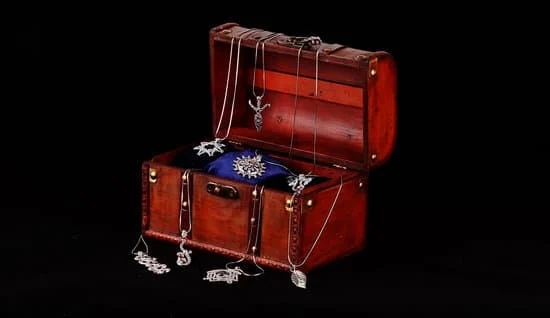The history of making art out of old jewelry has been a long-standing tradition that dates back to ancient civilizations. Throughout the years, individuals have found creative and innovative ways to repurpose old jewelry into stunning works of art. This practice not only honors the craftsmanship and history of the pieces but also adds new layers of meaning and significance.
Art and jewelry share a deep connection that spans across cultures and time periods. Both forms of expression often reflect the values, beliefs, and aesthetic preferences of a particular society or community. Additionally, the intricate techniques used in jewelry making often mirror those utilized in various art forms, creating a seamless blend between the two mediums.
As we delve into this fascinating topic, we will explore the evolution of jewelry making techniques throughout history and the cultural significance of repurposing old jewelry. We will also examine renowned artists who have made significant contributions to the world of art using old jewelry, as well as unravel the step-by-step process of creating art from these cherished pieces.
Join us as we embark on a journey through time, exploring how old jewelry has been transformed into timeless works of art.
The Evolution of Jewelry Making Techniques Throughout History
Throughout the history of making art out of old jewelry, the evolution of jewelry making techniques has played a fundamental role. From ancient civilizations to modern times, humans have used various methods and materials to create stunning pieces of jewelry. The earliest known jewelry dates back more than 100,000 years and was made from shell beads. Over time, as civilizations developed and trade routes expanded, new techniques and materials were incorporated into jewelry making.
One significant advancement in jewelry making came during the Bronze Age, when metalworking techniques allowed for the creation of intricate designs and patterns. The use of gemstones also became prevalent during this time, adding color and texture to jewelry pieces. In ancient Egypt, jewelry making reached new heights with the invention of the cloisonné technique, where colorful gemstones or glass are separated by thin metal strips to form beautiful patterns.
During the Renaissance period, there was a resurgence in interest for classical art and culture, leading to a revival in intricate and detailed jewelry designs. Advancements in diamond cutting techniques also allowed for a greater variety of shapes and styles. Fast forward to modern times, and technology has revolutionized jewelry making with innovations such as 3D printing and laser cutting. These techniques have opened up new possibilities for creating unique pieces from old or repurposed jewelry.
| History Milestone | Significance |
|---|---|
| Bronze Age Metalworking | Allowed for intricate designs in jewelry making |
| Renaissance Revival | Brought back interest in detailed jewelry designs |
| Modern Technology | Revolutionized jewelry making with new techniques such as 3D printing |
Cultural Significance of Repurposing Old Jewelry
The cultural significance of repurposing old jewelry is a practice that has deep historical roots in many different cultures around the world. Throughout history, old jewelry has been repurposed and transformed into new art forms as a way of honoring the past, preserving traditions, and infusing new life into precious materials. This section will explore the rich cultural significance of repurposing old jewelry and its impact on art and society.
Historical and Cultural Traditions
The history of making art out of old jewelry dates back to ancient civilizations such as the Egyptians, Greeks, and Romans, who were known for their skillful craftsmanship in creating intricate jewelry pieces. These cultures often repurposed old or broken jewelry into new designs as a way of honoring their ancestors and incorporating symbolism into their art.
Additionally, in Eastern cultures such as India and China, the tradition of transforming old jewelry into new art forms has long been practiced as a means of preserving cultural heritage and celebrating the interconnectedness of generations.
Symbolism and Meaning
For many societies, repurposing old jewelry holds deep symbolic meaning. In some traditions, it symbolizes rebirth, renewal, and continuity. For example, in certain African cultures, old beads are collected from ancestors’ graves and used in contemporary art to honor the deceased while also creating something new. In other cultures, using old jewelry in art represents a connection to one’s roots and a way of carrying on familial traditions.
Social and Environmental Impact
The practice of repurposing old jewelry carries significant social and environmental implications. By reimagining discarded or unused materials into new works of art, artists honor sustainability principles by reducing waste and promoting resourcefulness.
Some artists also use this practice as a way to bring attention to issues such as consumerism, materialism, and the value placed on material possessions within society. This approach not only adds historical depth to contemporary artwork but also contributes to larger conversations about culture consumption in the modern world.
Famous Artists and Their Work With Old Jewelry
Throughout history, many renowned artists have incorporated old jewelry into their artwork, creating unique and stunning pieces that showcase the beauty of upcycling. One such artist is Pablo Picasso, who was known for his innovative use of found objects in his artwork.
In the mid-20th century, Picasso created a series of assemblage sculptures using old jewelry, coins, and other discarded items. These pieces not only highlighted his creativity but also brought attention to the concept of repurposing materials in art.
Another influential artist who made an impact with old jewelry is Louise Nevelson. Nevelson was known for her large-scale abstract sculptures, often created using discarded materials such as wood scraps and yes – old jewelry. Her work challenged traditional notions of sculpture and inspired a new generation of artists to explore the possibilities of incorporating found objects into their art.
In addition to these iconic figures, contemporary artists continue to make waves in the art world by using old jewelry in their creations. From mixed media collages to intricate mosaic designs, these artists are pushing the boundaries of what can be achieved with repurposed materials. The work of these artists serves as a testament to the enduring appeal and versatility of using old jewelry in art.
| Artist | Artwork |
|---|---|
| Pablo Picasso | Assemblage sculptures using old jewelry |
| Louise Nevelson | Large-scale abstract sculptures incorporating old jewelry |
The Process of Creating Art From Old Jewelry
Creating art from old jewelry is a fascinating and intricate process that requires skill, creativity, and a keen eye for design. Artists who specialize in repurposing old jewelry use a variety of techniques to transform these forgotten pieces into stunning works of art. This section will provide an overview of the step-by-step process involved in creating art from old jewelry.
Gathering and Sorting
The first step in creating art from old jewelry is gathering and sorting through the various pieces. This may involve scouring flea markets, estate sales, or even digging through your own collection of unused jewelry. Once collected, the artist carefully sorts through the pieces, considering their colors, shapes, and materials to determine how they can be best utilized in their artwork.
Design and Planning
After selecting the jewelry pieces to be used, the artist moves on to the design and planning phase. This step involves sketching out ideas, arranging the jewelry pieces on a canvas or other surface to create a rough layout, and envisioning how the final piece will look. The artist must consider balance, harmony, and visual appeal as they plan out their creation.
Assembling and Securing
Once the design is finalized, the artist begins assembling the old jewelry pieces onto their chosen surface. This may involve cutting or rearranging pieces to fit their vision. Specialized tools such as adhesive resin or wire wrapping techniques are used to secure each piece in place. This part of the process requires precision and attention to detail to ensure that each element is securely fastened while maintaining its aesthetic appeal.
Through this step-by-step process, artists are able to breathe new life into old jewelry by transforming it into beautiful works of art that captivate audiences with their unique charm and history.
The Modern Revival of Using Old Jewelry in Art
Ways in Which Old Jewelry Is Being Used in Modern Art
Some artists are incorporating old jewelry into mixed media pieces, creating intricate and visually captivating compositions. Others are taking the individual components of old jewelry, such as gemstones, beads, and metal trinkets, and using them to create entirely new pieces with a historical touch. The use of old jewelry in art serves as both a nod to the past and an innovative approach to creating contemporary works.
The Rise of Artisanal Workshops on Jewelry Upcycling
With the increasing interest in sustainability and upcycling, artisanal workshops focusing on repurposing old jewelry have become popular. These workshops offer individuals the opportunity to learn new techniques for transforming outdated or broken jewelry into one-of-a-kind pieces. Participants not only gain valuable skills but also contribute to reducing waste by breathing new life into forgotten items.
The Influence of Social Media on the Upcycling Movement
Social media platforms have played a significant role in the resurgence of using old jewelry in art. Artists and creators showcase their upcycled creations online through platforms such as Instagram and Pinterest, inspiring others to try their hand at repurposing old jewelry. This sharing of ideas has contributed to the growing community dedicated to sustainable art practices and has brought attention to the historical significance of making art out of old jewelry.
The Impact of Sustainability on the Art of Upcycling Jewelry
There are several ways in which sustainability has impacted the art of upcycling jewelry. Firstly, it has led to a shift in consumer behavior, with more people seeking out unique, handcrafted pieces made from repurposed materials.
This has created a demand for artists who specialize in creating art from old jewelry, thereby promoting sustainable practices within the art community. Additionally, the emphasis on sustainability has encouraged artists to develop innovative techniques for working with old jewelry, finding new ways to transform and repurpose these materials into beautiful works of art.
Furthermore, sustainability has influenced the way old jewelry is sourced for artistic purposes. Instead of relying on newly mined materials, artists are often sourcing old jewelry from vintage stores, flea markets, and even personal collections.
This not only reduces the demand for newly produced jewelry but also gives new life to forgotten or discarded pieces. Overall, sustainability has significantly shaped the art of upcycling jewelry, inspiring both artists and consumers to value creativity and resourcefulness in the creation and appreciation of art.
- The use of sustainably sourced materials
- Innovative techniques for transforming old jewelry
- A shift in consumer behavior towards supporting sustainable practices
Exploring the Future of Art Made From Old Jewelry
In conclusion, the history of making art out of old jewelry is a rich and fascinating journey that reflects the deep connection between art and jewelry. From ancient civilizations to modern times, the evolution of jewelry making techniques has shaped the cultural significance of repurposing old jewelry into works of art. Throughout history, famous artists have showcased their creativity by transforming old jewelry into stunning pieces that continue to inspire and captivate audiences.
The process of creating art from old jewelry involves a meticulous step-by-step approach that requires both skill and imagination. As we look towards the future, there is a modern revival of using old jewelry in art, driven by the growing impact of sustainability on upcycling practices. This trend reflects a conscious effort to reduce waste and environmental impact while also celebrating the beauty and craftsmanship of vintage jewelry.
As we explore the future trends and innovations in the art made from old jewelry, it is evident that there is a growing appreciation for sustainable practices and a renewed interest in preserving the heritage of old jewelry. Artists continue to push boundaries by incorporating new materials, techniques, and technology into their work, giving rise to exciting possibilities for the future of this artistic tradition.
With a focus on sustainability and innovation, the art made from old jewelry is poised to continue captivating audiences for generations to come.
Frequently Asked Questions
What Is the History of Art Deco Jewelry?
Art Deco jewelry originated in the 1920s and 1930s, characterized by geometric shapes, bright colors, and a focus on luxury and modernity. It reflected the societal shifts of the time, including women’s emancipation and technological advancements.
What Is the History of Retro Jewellery?
Retro jewelry, also known as cocktail jewelry, emerged during the 1940s and was influenced by Hollywood glamour and WWII-era materials restrictions. It featured large gemstones, bold designs, and intricate metalwork, often crafted from gold or platinum.
What Is the Art of Making Jewelry Called?
The art of making jewelry is called “jewelry making” or “jewelry fabrication.” It involves techniques such as soldering, sawing, forging, casting, stone setting, enameling, and other skilled processes to create wearable works of art.

Welcome to my jewelry blog! My name is Sarah and I am the owner of this blog.
I love making jewelry and sharing my creations with others.
So whether you’re someone who loves wearing jewelry yourself or simply enjoys learning about it, be sure to check out my blog for insightful posts on everything related to this exciting topic!





